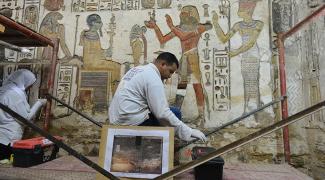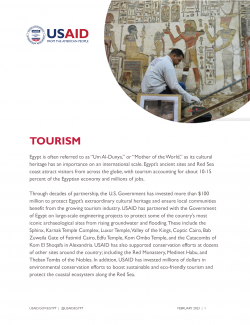Egypt is often referred to as “Um Al-Dunya,” or “Mother of the World,” as its cultural heritage has an importance on an international scale. Egypt’s ancient sites and Red Sea coast attract visitors from across the globe, with tourism accounting for about 10-15 percent of the Egyptian economy and millions of jobs.
Through decades of partnership, the U.S. Government has invested more than $100 million to protect Egypt’s extraordinary cultural heritage and ensure local communities benefit from the growing tourism industry. USAID has partnered with the Government of Egypt on large-scale engineering projects to protect some of the country’s most iconic archaeological sites from rising groundwater and flooding. These include the Sphinx, Karnak Temple Complex, Luxor Temple, Valley of the Kings, Coptic Cairo, Bab Zuweila Gate of Fatimid Cairo, Edfu Temple, Kom Ombo Temple, and the Catacombs of Kom El Shoqafa in Alexandria. USAID has also supported conservation efforts at dozens of other sites around the country; including the Red Monastery, Medinet Habu, and Theban Tombs of the Nobles. In addition, USAID has invested millions of dollars in environmental conservation efforts to boost sustainable and eco-friendly tourism and protect the coastal ecosystem along the Red Sea.
CURRENT PROGRAMS
RED SEA INITIATIVE: USAID’s decades-long partnership with the Government of Egypt has ensured ongoing protection and long-term strategies to preserve the natural environment and helped local communities build resilience to the shocks of climate change. In 2022, USAID launched the Red Sea Initiative – an ambitious climate action aiming to conserve the Red Sea’s coastal ecosystem, while promoting high-value, low-impact ecotourism. The Red Sea Initiative plans to: protect the Red Sea’s coral reef and surrounding coastal ecosystem against the impacts of climate change and human activity; empower local communities to lead on climate action; establish a blended finance mechanism to support businesses in building resilience against climate change, reducing emissions and creating jobs; and partner with private businesses and other donors to leverage up to $50 million in total funding. To advance the work of the Red Sea Initiative, USAID will collaborate with the United Nations Global Fund for Coral Reefs (GFCR) to enlist additional donors and investors from the public, private, and non-profit sectors to conserve the Red Sea’s coastal ecosystem for future generations.
INTEGRATED MANAGEMENT OF CULTURAL TOURISM: Current global trends demonstrate a growing preference among visitors for more experiential and authentic travel versus traditional package tourism. Building a platform for unique and sustainable tourism in Egypt is critical to the industry’s long-term success and is in line with USAID’s commitment to sustainable development. Through the Integrated Management of Cultural Tourism project, USAID partners with the Government of Egypt to streamline laws and regulations and develop public private partnership models that incentivize private sector investment in cultural tourism. The approach seeks to not only restore physical structures, but also add economic value by incorporating business opportunities, such as entertainment and event spaces. The program builds the capacity of micro-, small-, and medium-sized enterprises to capitalize on cultural tourism. Focusing on Historic Cairo and Luxor, the program will increase Egypt’s tourism revenues, benefiting the local communities that live in and around historic sites.
Implementing Partner: FHI 360; Life of Project: November 2020 – October 2024; Total Estimated Cost: $13 million; Governorates: Cairo and Luxor.
VISIT-Esna: Esna, a city rich in cultural heritage, was forgotten by tourists when a new dam built in 1994 allowed for faster passage by cruise ships. In the ensuing years, businesses closed and unemployment skyrocketed, forcing residents to abandon the area in search of new jobs and leaving the city center in a state of disrepair. To put Esna back on the map and create sustainable jobs, USAID and Takween are partnering with the Ministry of Tourism and Antiquities, the Luxor Governorate, the Ministry of International Cooperation, and other public and private stakeholders to restore historic landmarks, revitalize Esna’s tourism infrastructure, and showcase Esna as a prime tourist destination for tour operators, investors, and the public. The program developed a new Esna brand to highlight the city’s diverse heritage assets, ranging from traditional cuisine to historic sites. In Esna, USAID restored an 18th century caravansary (Wakalat El Geddawy), Al Qisariya Market, and several building facades. The program trained and integrated the local community in an array of activities, from guiding tours to reviving local handicraft traditions, with an aim to generating new job opportunities, increasing revenues, and advancing economic benefits for the community.
Implementing Partner: Takween Integrated Community Development; Life of Project: October 2016 – September 2024; Total Estimated Cost: $8.6 million; Governorate: Luxor.
MEDINET HABU AS OPEN-AIR MUSEUM: Located on Luxor’s west bank (ancient Thebes), Medinet Habu is best known for its well-preserved mortuary temple of Ramesses III, who reigned from 1186 to 1156 B.C.E. The site also houses archaeological monuments spanning from 2100 B.C.E. to 900 C.E. Chicago House has been working at Medinet Habu off and on over the last century to document and conserve all of the monuments in the complex. Since 2015, USAID has supported Chicago House’s restoration of the archaeologically-rich Medinet Habu to increase tourist interest in the temple complex. Site improvements include a walking path and an open-air museum.
Implementing Partner: University of Chicago Oriental Institute - Chicago House; Life of Project: October 2015 – September 2023; Total Estimated Cost: $6 million; Governorate: Luxor.
Cultural Heritage and Tourism in Egypt II: Khonsu Temple is situated in the south-west corner of the Karnak temple complex in Luxor. It was built during the reign of Ramses III and dedicated to Khonsu, son of Mut and Amun. In neighboring Sohag, Abydos was the most important burial site of ancient Egypt and has a history extending back some 7,500 years. It served as the cult center of the ancient Egyptian god Osiris, ruler of the land of the dead, and was a place of great religious importance. USAID is partnering with the American Research Center in Egypt (ARCE) on physical improvements to Khonsu Temple in Luxor and the Osireion in Abydos through conservation and restoration efforts, thereby improving the quality of tourists’ experience. ARCE will also build the capacity of the Ministry’s staff to better protect and manage the sites as well as provide employment and training for semi-skilled labor from the local population.
Implementing Partner: American Research Center in Egypt; Life of Project: February 2023 – September 2024; Total Estimated Cost: EGP 32.4 million (equivalent to $1.1 million); Governorate: Luxor and Sohag.

Mohamed Abdelwahab for USAID

